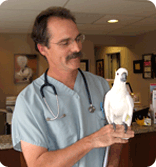Sick Eclectus Parrot

I recently took my 4 year old eclectus parrot to the vet, because he was acting very quiet for a full day and into a second day. The vet noticed some swelling in the ridges in the upper back of the beak (sorry I forget the correct name). He looked at some poop under a microscope and saw some blood. He took an xray and said that the upper stomach area (proventicular?) looked unusually large and he was concerned about possible PDD. He gave me a Celebrex solution and said I should give my bird the Celebrex for 6 weeks. But, also, this means that my bird is not cleared to use the bird sitter. But, the blood test came back showing some bacteria, and I started a 10 day regimen of antibiotics, as well. On the 4th day my eclectus seemed close to normal, and at 9 days still seems like his old self. However, the vet said we cannot know whether it was the antibiotic or the Celebrex treating the PDD symptoms. I’ve read everything I can on PDD, and it makes no sense to me that this could be PDD. There was no weight loss. There was no passing of undigested food. The antibiotics made him better in a few days. But, now he is in limbo as far as being cleared to use a bird sitter, which is problemmatic for us. I’ve stopped the Celebrex, because it is $40/bottle. Should I continue the Celebrex or find a new vet?

It is impossible for me to be able to provide any form of accurate medical recommendations for your bird in the absence of direct consultation with your attending veterinarian or physically seeing your bird. The combination of clinical data that you mention, I agree, is not classically consistent with Proventricular Dilation Disease (PDD). Alterations in the choanal area and its papillae are non-specific, and do not necessarily correlate with any specific disease. Enlargement of the proventriculus, when seen radiographically, can be seen in Eclectus parrots that sometimes have no clear disease - their proventricular silouettes are sometimes larger than many other parrot species. Bloody feces are not typically noted with PDD. Alterations in complete blood count may suggest stress, or an inflammatory reaction to something, but are not necessarily clearly indicative of infection in and of themselves. The details are interpretively important, and all are dependent on the clinical history and physical examination findings of your veterinarian.
Clinical signs are grouped into two general systemic categories: neurological and gastrointestinal. Neurological signs of PDD include ataxia, blindness, abnormal head movements, seizures, loss of balance, depression and paralysis. Gastrointestinal signs of PDD include the passage of undigested seeds in feces, proventricular enlargement, diarrhea, lethargy, weakness, weight loss, starvation and death. All of these clinical signs can progress at variabe rates, and technically *any* clinically ill bird could have this disease as a possible inclusion in its differential diagnosis list. PDD at present time, is definitively diagnosed by biopsy of the effected organs, allowing for identification of the classic inflammatory lesions that are used to define the disease. The location of biopsy is dependent on clinical signs that are noted, and the level of concern and need for definitive diagnosis. Although avian bornavirus (ABV) has recently been identified as an etiologic agent of Proventricular Dilation Disease (PDD), testing for its presence, alone, does not confirm the presence of PDD. Only ABV 2 and ABV 4 have been strongly associated with PDD, and ABV types 1, 3, and 5 have not been associated with disease at present time. Surveyed populations of parrots can easily show a prevalence of 30-60% in apparently healthy birds. This disease is technically described as as one that is not treatable, although high doses of non-steroidal anti-inflammatory drugs including celebrex or meloxicam can sometimes show clinical improvement in individuals. These birds typically do not show improvement in as short a time as you have described in your bird here.
It sounds like there may no clearly established diagnosis at present time, and that your bird is feeling better after a course of antibacterial and non-steroidal anti-inflammatory drug treatment. This information, alone, is fairly far removed from clear evidence of PDD and a need for absolute quarantine from other birds. It still, however, should be possible that this disease could be present.
I would suggest that you speak with your veterinarian about your concerns, and also ask for specific recommendations about your relative risks of continuing to have your bird overlooked by your bird sitter.

































